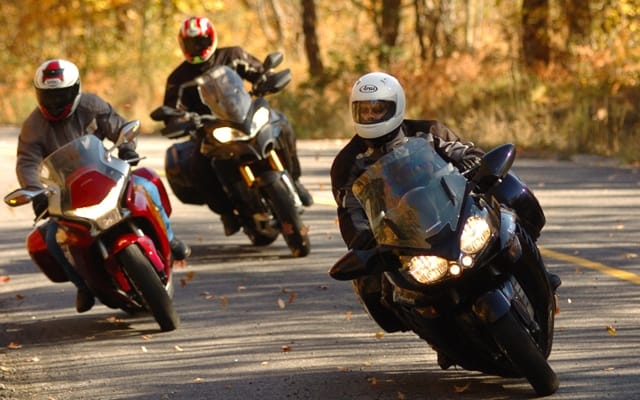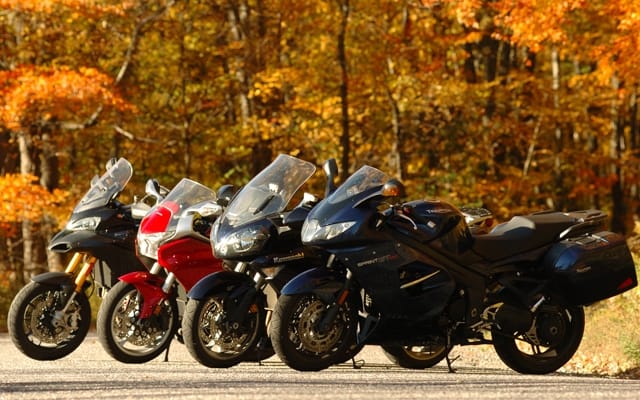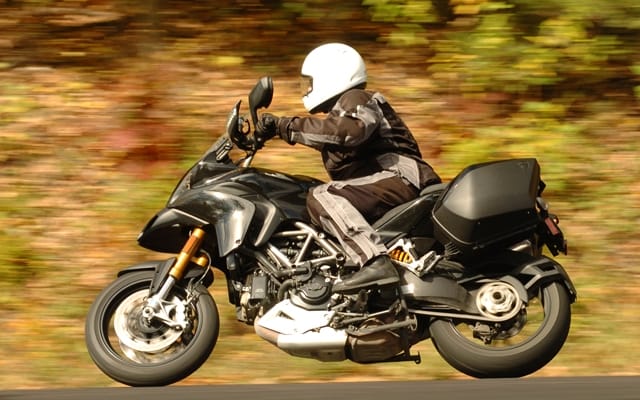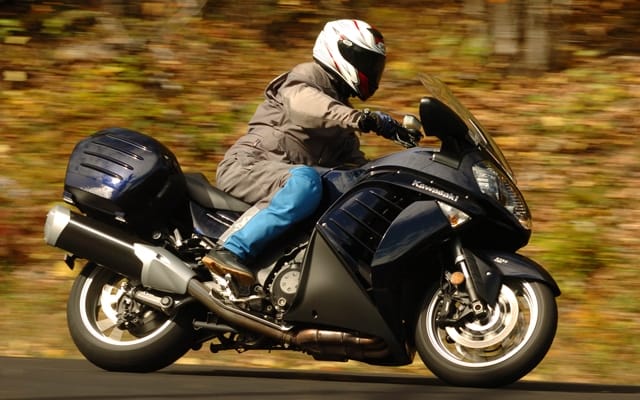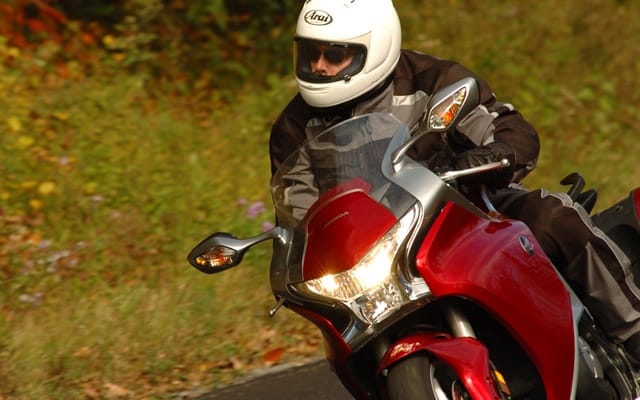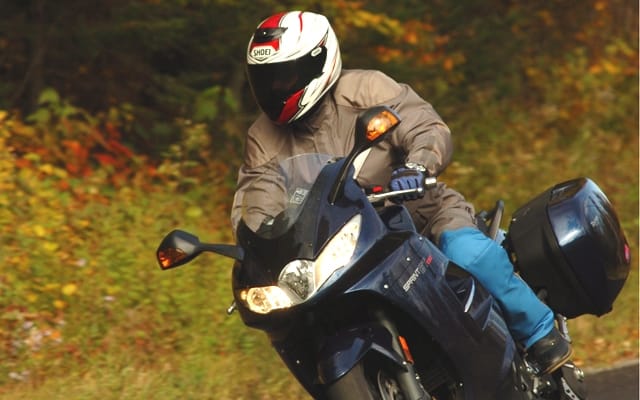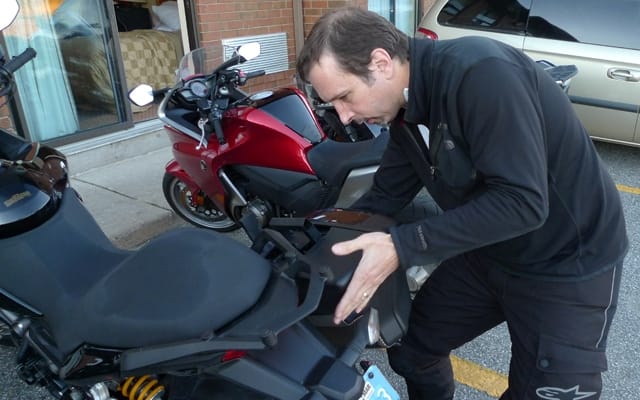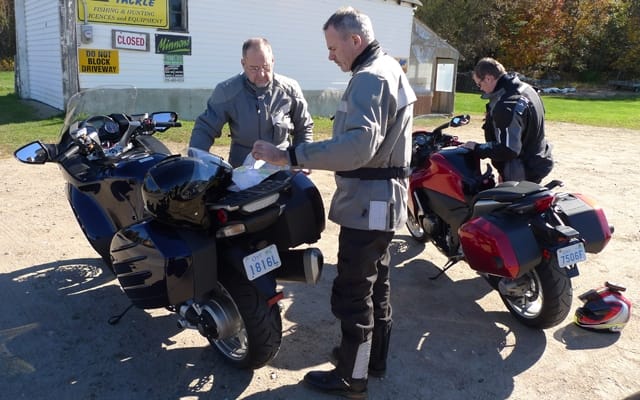For this year’s Cycle Canada Fall Tour we took Honda’s VFR1200, Kawasaki’s Concours 14, Triumph’s Sprint GT and Ducati’s Multistrada 1200 in search of twisty central Ontario roads to see how the 3 classic sport tourers and 1 adventure tourer stack up against each other.
Once again Derreck Roemer captured our Fall Tour impressions on video, but unlike last year’s 3-1 vote for KTM’s 990 Adventure, the 2010 Fall Tour Challenge saw no clear winner. Each of us chose a different bike this year, with the exception of our editor Neil Graham, who as you’ll find out below chose all four. Here then are each rider’s detailed impressions of our 2010 Fall Tour motorcycles.
Paul Bremner
A pity my first ride was the Honda, because the VFR is a brute. The seating position is hard and uncompromising, with a thinly padded saddle, low bars and high pegs. The capacious saddlebags feel out of place—would you really want to travel on this bike?
It’s a bike that doesn’t feel terribly fast until you look at the speedometer; on the VFR, 100 km/h and 150 km/h feel very much the same. Thankfully, the linked brakes are a wonder, hauling the bike down from supra-legal speeds with the touch of a single finger. Once the road turned twisty, however, I discovered that the Honda demands a firm hand. Its steering is heavy, and necessitates a hard shove on the handlebar to initiate turns.
On day two I looked forward to a new riding companion: the Triumph Sprint GT. On paper, the Sprint seems like the dark horse in this group. It has the least horsepower (“only” 128), and no traction control, shaft drive, or heated hand grips. And yet, on the road, it was a front-runner. The riding position is less extreme than the Honda’s, but sporty enough to allow aone-cheek-on-the-saddle cornering posture. The saddle is firm but comfortable, and the bike feels narrower than the burly VFR and the beefy Concours.
On the last day of our tour, riding the serpentine Southwood Road near Bala, Ontario, Neil, Derreck and Steve once again shifted into attack mode. Keeping pace on that kind of road had been a struggle on the Honda, but on the Triumph I kept the other riders firmly in my sights, arcing through each corner with confidence, then powering out in search of the next apex, the big triple wailing in my ears. A grand way to tour, indeed.
Later that evening the rainy weather we’d been running from finally caught up with us. Luckily it was my turn on board the Concours. I say “on board” because piloting the Kawasaki is akin to flying a Lear Jet: it’s fast, responsive, and luxurious, and it leaves you feeling sorry for less fortunate travelers.
With the possible exception of a BMW R1200RT that I had previously sampled, there was no better bike to be riding through that cold October rain. The electrically adjustable windshield diverted the rain cleanly over my helmet; the scoop of the fairing protected my knees and shins from spray; and the heated grips kept my hands toasty. Although it’s a large motorcycle—80 pounds heavier than the Honda and the Sprint—the Concours feels nimble and stable at all but the fastest pace on the tightest road. And KTRC traction control lessens the worry of sandy corners and gravelly roadwork.
Prying Derreck’s hands off the Ducati’s heated grips wasn’t easy, but I managed to get an afternoon on the Multistrada S. How would a multi-purpose, multi-strada motorcycle compete against bikes created in the standard sport-tourer mould? The engine is astonishingly powerful. If the Honda roars, the Sprint whines, and the Concours whooshes, the Ducati snarls, snapping forward the instant you twist the throttle. Although the power is ferocious, this is not an intimidating motorcycle. Sitting up tall, with the wide, flat bars in hand, you’re the master of your domain. That sense of control is accentuated by the Ohlins suspension, which gives excellent road feel without choppiness.
I found the Ducati’s adjustable suspension and power characteristics to be useful. I spent most of my time in Touring mode, which gave a more supple suspension setting and a slightly more progressive power curve than the balls-out Sport mode. But on a trip down Elephant Lake Road, a one-time sportbike destination now covered in deep, loose gravel, I switched to Enduro mode. As my colleagues floundered through on their heavier bikes, the Ducati’s magnificent suspension and precise traction control allowed me to saunter away at a relaxed 80 km/h.
The Ducati is close to perfect. At $21,000 it’s double the price of my Suzuki V-Strom, but it’s twice as competent and almost three times as powerful. Sounds like a great deal to me.
Derreck Roemer
I’ll come clean and say straight off that I was biased. Having already ridden the Multistrada 1200 over 1,000 kilometres in April, and afterward considering robbing a bank in order to buy one, I was sure I’d choose it as the best of the bunch—even before I rode the other three bikes. I was wrong.
It wasn’t that the Multistrada—with its comfortable upright seating position, flexible 140 hp engine, and infinitely adjustable electronic suspension and traction control—had lost a step over the summer. Attacking the 518’s twists and turns on our first day once again confirmed the Multistrada’s deftness as an extremely sporty and confident back-road tourer. But this was the S-Touring model, which trades the carbon fibre trim of the S-Sport I had ridden in the spring for heated handgrips, hard luggage, and a centrestand.
The three-level hand warmers, controlled by the starter button while the bike is running, were a welcome addition on cool fall mornings and worked exceedingly well. And the centrestand worked impeccably. But the luggage did not.
With daylight shining through the gap between the lid and the body of the case when it was locked shut, it was clear something was amiss. Ducati has announced that it will foot the bill to retrofit all 2010 models with new luggage that has additional clasps to secure lid to body—so if you own a Multistrada you won’t be left in the cold (or damp). But the not-so-user-friendly luggage mounting system will remain unchanged.
After 10 unsuccessful minutes of trying to detach the side cases, I gave in and phoned Ducati for instructions. “Oh no, you’ll never get them off by pulling,” I was told. “You have to swiftly hammer each one from the front with your knee.” Should a mixed martial arts technique really be required to remove the panniers from a $21,000 motorcycle?
Attaching the Multistrada’s luggage was even more frustrating. As the rest of our group quickly snapped their weatherproof cases onto their bikes each morning, I cursed and coaxed and struggled to find the proper mounting alignment on mine.
On our last afternoon I looked on with dismay as the lid popped open on the Ducati’s left case while the bike was moving. Luckily, nothing fell out, but the case’s outer half is permanently scarred. And so, as much as I still love this machine, I can’t pick a motorcycle with such poorly designed luggage as my favourite.
The afternoon of day two found me aboard the Concours 14. Riding at our usual spirited pace, as the turns tightened near the southern end of road 65 on the way to Calabogie, I struggled to keep the Kawasaki on the right side of the road and was forced to slow my pace. While the plushness of the Concours 14 was pleasant on highways and gently sweeping country roads, its vague feedback and substantial girth were off-putting in sportier situations. Though, it must be said, its electrically adjustable windscreen, cushy seat, and heated handgrips made it the bike to be riding on the following day of cool temperatures and rain.
When the rains came I was on the Triumph, a less expensive bare-bones tourer that mercifully had a power socket for me to plug my electric vest into. Though I’m a fan of Triumph’s torquey triples, with their smooth power and raspy voice, I was unmoved by the Sprint GT, and found it almost as staid as the Kawasaki and not much more comfortable than the VFR. Its seat, for instance, was the least comfortable of all four motorcycles, causing soreness in less than an hour of saddle time.
My vote, then, falls to the VFR, which is unexpected; just as I had anticipated favouring the Multistrada before the trip, I was also certain that the Honda would be my least favourite.
When you’re standing next to it, the VFR1200 is more attractive than in photographs, and though its pegs are a little high and its handlebar a little low, its power is impressive and the sure-footed handling a revelation, and its brakes were the best of the bunch. For someone like me, who is only happy on a bike when it’s leaned over, it’s the kind of motorcycle you want to be on when the road gets interesting. If you think of it as a tourer you’ll be disappointed. But as a comfortable sportbike with decent luggage, it’s hard to beat.
Neil Graham
There is no perfect motorcycle. At best you’ll find a machine ideal for the kind of road you’re on in the kind of mood you’re in. That’s it. And while every one of these four suited, at one time or another over our journey, the road and my mood, it was left to serendipity for the right bike to fall into my hands at the right time. As the leader (the one with the credit card) of our troupe as we traipsed through the countryside, I could have manipulated machine allotment to suit my mercurial needs—but that wouldn’t have been very sporting of me, would it?
So it meant that during the cold rain from Perth to Bancroft I was on the Multistrada and not the luxurious Concours, with its headed grips and cocoon-like cockpit. It also meant that on highway 518 I was on the Triumph, and not the more athletic VFR or Multistrada. It was clear that the best bike of the bunch would then be the one with the most malleable personality—the one best able to do the most number of things with competence.
While I had a sense of what to expect from the Kawasaki, Triumph, and Ducati, I was unsure of the Honda. I had ridden the VRF twice before—for an hour in single-digit temperatures at a Honda press launch and then for a day at Mosport raceway at yet another Honda event. On my first experience I was so cold that I was only vaguely aware of the machine beneath me, while at the racetrack the VFR seemed a little too heavy and a little too softly suspended. But out here, in the real world on this fall tour, ridden on the kind of roads that it was designed for, it was a revelation. The V-four engine is powerful and suffused with torque, and the suspension that seemed to waffle on the racetrack was every bit the equal of the Ducati’s Ohlins suspension (though, it must be said, without the Ducati’s on-the-fly adjustability).
Even the looks of the thing improve when you’re in its presence, as it seems small and supremely well bolted together. But despite Honda’s claims that it has a stirring exhaust note, to my ear it’s overly stifled. I just assumed that it had to be so quiet to meet noise regulations, and yet next to the Aprilia RSV4 (itself a V-four) in our back lot, which was also fitted with a stock exhaust system, the Honda was inaudible. I like quiet motorcycles (especially if they’re not being ridden by me), but Honda has been overly conservative with the VFR, especially since the V-four engine configuration offers the potential for the sweetest sounds in motorcycling.
I think part of the lackluster response to the VFR by both press and enthusiasts can be attributed to the shifting sands of the sport touring market. After stepping off the VFR (which is, despite the whining of Paul Bremner, a comfortable sport-touring bike in the classic sense) and onto the Ducati, it felt like slipping into a hot tub. The bloated dirt-bike riding position of the Multistrada (and you can add BMW’s R1200GS, KTM’s Adventure, Suzuki’s V-Strom, Yamaha’s new Super Tenere and Honda’s own Varadero, among others, to that list) is the most relaxing way to sit on a motorcycle this side of a Gold Wing. In fact, if it weren’t for the Wing’s squishy saddle and superior wind protection, it would be more comfortable than a Gold Wing. Really.
Yet the Ducati’s riding position doesn’t come at the expense of machine control or cornering clearance—it really is a case where you can have your cake and eat it too. At least as long as you don’t keep your cake in the Ducati’s side case (as Derreck Roemer details in his notes) as rainwater will have turned it to inedible slurry.
The Sprint GT and Concours 14 are old-school sport tourers like the Honda, but they’re progressively more luxurious. The Sprint is a VFR with its belt let out a notch, while the Concours gets rid of the belt altogether in favour of suspenders. The Kawasaki very deftly skirts the line between sport touring and luxury touring.
While I was more than happy to ride any of our quartet, it was the Ducati, and more specifically the Ducati’s riding position, that would have made it my choice if it came down to picking one machine. But until I get a chance to test the updated bags I’ll throw my support behind the Triumph, though if the road begins to twist and tighten I’ll switch my allegiance to the Honda. Rain? They’re calling for rain? Well, in that case I’ll take the Kawasaki. After all, I have the credit card; that should be worth something.
Steve Thornton
Coming back to the motel after dinner, I looked at the bikes lined up in the parking lot. They faced away from us, and the view of their side-by-side tail sections was striking. One bike looked like a pure sportbike. The Honda VFR1200.
The Honda’s motor is very strong, its suspension is firm and well sorted, and its ergonomics—unfortunately, in my view—are nearly those of a full-on sport machine. It’s a gas to ride hard on a twisty road. For a long ride without twisties, I recommend a trailer.
The Triumph Sprint GT feels somewhat bland compared to the Honda, though it also feels narrower and lighter. Those are good things. The slight hesitation when you apply throttle, however, and its lack of real torque down low, are not good things.
The Sprint is a good-looking, reasonably comfortable motorcycle that on a fine fall day with a curving, scenic road was a terrific companion. It’s a little more comfortable than the VFR and the three-cylinder motor has a nice rasp to it that you hear and feel when you roll on the throttle. That’s not quite enough to make me want to own one, however.
The Ducati Multistrada 1200. I could almost stop right there. It’s like saying NASA, or the Beatles. However, it’s worth mentioning that the footpegs are so comfortably low and the wide handlebars are so comfortably high that even if the bike behaved like a bitch you’d still want to ride it. And it doesn’t behave like a bitch; it’s just about perfect.
The Kawasaki Concours 14 was my bike for two runs of the second best road of our 2010 Fall Tour, and when I pressed it hard, it responded in ways that pleased me. The motor is so strong that you can leave it in any gear you choose and let its horsepower and torque do your work. And for a bike that weighs more than 300 kilograms, it responds well to a steering input. In the twisties of Hwy 518, it did not feel like an overweight touring bike. It encouraged me to go fast, then faster, and it responded quickly and accurately. I also had the Concours for a couple of long drones on Hwy 400, and there it was a comfortable vehicle. Its heated grips, with an infinitely adjustable dial, its height adjustable windscreen with a handlebar switch for on-the-fly adjustments, its wide seat and high handlebar—all of it contributed to my comfort.
The Concours is equipped with linked ABS brakes that the rider can shift between two modes in order to change the amount of front brake that’s added when you step on the rear brake pedal—a little, or a lot. There is also a traction control system that you can turn on and off. I pulled onto a dirt driveway and opened the throttle fully in first gear, and the bike responded by going into a low-power mode that felt like that of a sick 250. I felt no inputs from the system, just suddenly the bike didn’t have more than about 10 horsepower, and there was no loss of rear wheel traction. There was also no lag time before it worked; it was right there.
Before we left on this tour, I decided that I’d need my Macbook Pro, a 15-inch laptop, and I did not want to carry it in a backpack. I was therefore pleased to note that it would fit into the Concours’s saddlebags. In fact, Derreck Roemer added his own laptop to my saddlebag. They were so voluminous that I couldn’t really fill the second bag without help, and even with two laptops plus a digital camera, there was room for more in the right side bag.
The bags were easy to remove and went back on quickly and securely, with a slot at the lower back end of each bag fitting over a tang on the bike, then two latches closing around the two upper hook-type mounts when the lifting handle was closed. If the handle was closed on that bag, it was locked in place.
My single complaint about the Concours concerned its key. Not the key, that is, but the key fob, which must be within a metre or two of the ignition for the bike to work.
You can turn the key to lock the steering, then leave it in the ignition and walk away—nobody is going to move it or unlock anything unless that fob is near. The fob also needs to be close in order to withdraw the key for use on the saddlebag locks. Leave it in your motel room, and you won’t be getting into your bags. However, by the end of the tour we were remembering to keep the damn key fob near the bike. I suppose if four magazine writers can do that, anybody can.
